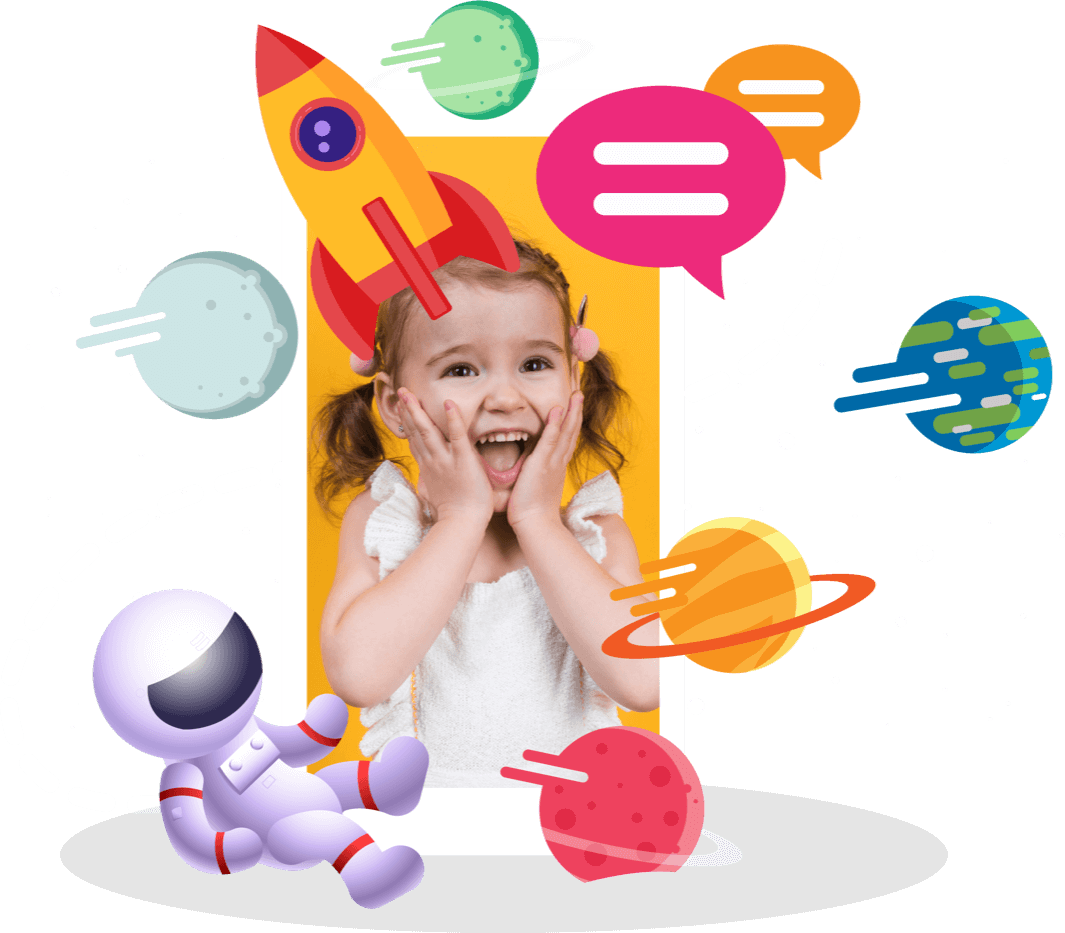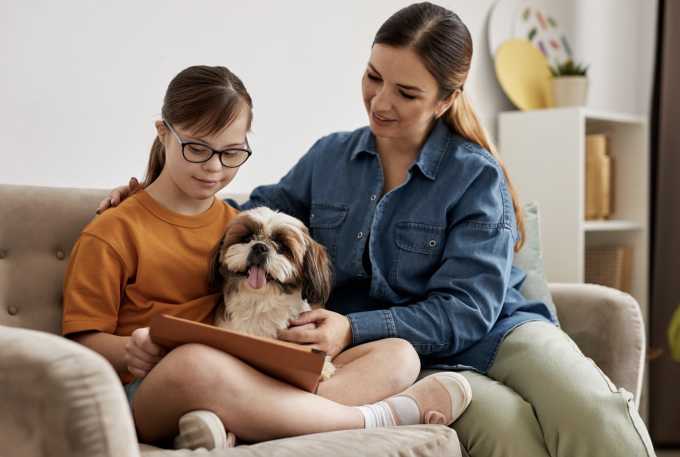Approximately one third of children with autism are nonverbal. This means that they never learn to speak more than a few words in their lives.
Why Can’t My Autistic Child Speak?
There may be a couple of reasons that a child with autism doesn’t speak. The primary identifying aspect for nonverbal autism is determining whether or not the individual speaks clearly or with interference.
Although there are individuals with autism that may struggle with having a back-and-forth conversation, these are not nonverbal autistic people. Those who are nonverbal don’t speak at all.
Let’s look at the reasons why this may be happening. Autistic children could lose the ability to speak later on as the disorder’s symptoms worsen over time.
The individual could also be suffering from apraxia. This can cause the person to not be able to say what they want to say.
Autistic individuals could also suffer from echolalia, which is the repetition of words and phrases. This could also hinder clear communication.
Read: How to treat Echolalia in a Child with Autism
In addition, there are social, behavioral and developmental symptoms for nonverbal autism.
Social symptoms: Social interaction difficulties are a hallmark symptom of autism spectrum disorder. Individuals generally avoid eye contact. They don’t respond when their names are called. These could cause the individual to feel left out and isolated and may lead to depression.
Developmental symptoms: Each individual is unique. Every autistic person develops at a different rate. While a child can develop at a typical rate, their developmental progress could be delayed after the age of 2 or 3. This could be the case for speech as well.
Behavioral symptoms: Individuals with autism strictly stick to routines. Interruptions in these routines or schedules could upset them. Some have really specific interests and obsessions about certain objects and topics. They may have a short attention span, causing their focus to switch from one thing to another, which could affect communication. Behavioral symptoms really differ for each person.
Not all individuals show the same symptoms, and symptoms may improve with age as they become less disruptive and severe.
Through speech therapy and speech interventions, nonverbal autistic children could become verbal in time with the right and continuous help and support.
A nonverbal autistic two years old may not respond when their name is called A nonverbal autistic three years old may not play pretend A nonverbal autistic four years old may repeat words and phrases that are not meaningful A nonverbal autistic five years old may have trouble interpreting gestures in communication setting.
Causes of Autism
The definitive cause of autism is still being studied. However, research suggests that there is no single cause for the disorder.
Autism appears to develop from a combination of genetic and environmental factors.
These factors are found to impact and increase the risk of a child developing autism spectrum disorder. Increased risk doesn’t mean that the individual will certainly develop the disorder.
Some of the individuals that have risk factors associated with autism don’t have the disorder.
Studies suggest that the disorder:
- Could be inherited,
- Could result from abnormal levels of chemicals in the brain
- Could be caused by infection or the effects of an environmental toxin
Genetic risk factors: Genetics were found to affect the risk of some forms of autism. It is known that if an individual has a sibling or a parent with ASD, they are more likely to develop the disorder. In addition, some medical conditions were linked to autism spectrum disorder. Genetic disorders such as Fragile X syndrome are included in these conditions.
Environmental risk factors: Some experts suggest that exposure to heavy metals and toxins in the environment may raise the risk of developing ASD. Also, CDC indicates that children born to older parents are at higher risk for developing autism spectrum disorder. Certain prescription drugs such as thalidomide and valproic acid have been linked to autism development as well.
As can be seen, both genetics and environment could determine whether a child will develop autism or not. Autism is NOT caused by vaccines.
An abundance of research conducted on the matter concluded that the disorder is not caused by vaccines. The infamous study done in 1998 suggesting a link between autism and measles, mumps, and rubella (MMR) vaccine has been debunked multiple times and retracted in 2010 .
Diagnosis of Nonverbal Autism
There is no specific single test that determines nonverbal autism. A multi-phase process is conducted to diagnose the disorder.
When your child is at the pediatrician, they will be the first healthcare providers to assess for ASD. Parents and caregivers will sound their concerns to their doctor if they notice any symptoms.
The pediatrician then could request various tests to rule out other possible causes for the concerning symptoms. They may conduct physical examinations, blood tests, and MRI or CT scan imagings.
Pediatricians then refer your child to a specialist if they suspect autism spectrum disorder. Specialists will evaluate the medical history of the child as well as the parents.
After all of the extensive testing, autism-specific tests may be used to confirm the diagnosis of the disorder.
These tests include Childhood Autism Rating Scale Third Edition (GARS-3) and Autism Diagnostic Observation Schedule, Second Edition (ADOS-2) They will help clinicians determine whether the child has nonverbal autism.

Do Nonverbal Autistic Toddlers Babble?
Around 40% of autistic children don’t speak. Some others may speak while also having limited language and communication skills.
Babbling occurs when a newborn is practicing for speech. They open and close their mouths, move their tongues in different ways.
When typically developing babies babble, they begin their early development of language.
People with autism sometimes produce certain nonsensical speech sounds. These are called jargon. Sometimes they are self-stimulatory behaviors.
Generally, they are not used to communicating with others. The rate of babbling in nonverbal autistic individuals is low compared to their typically developed peers.
However, babbling could represent precursors to speech in an autistic child with speech-language delay.
Research suggests that the majority of nonverbal 4-year-olds with autism can develop spoken language if they have relatively strong social engagement and don’t have intellectual disability.
If a nonverbal child with autism babbles along with eye contact or gestures directed towards other people, this behavior could be worked on to be used as a tool for meaningful social and communication exchanges.
When is it Decided an Autistic Child is Verbal/Nonverbal?
Each individual develops at their own rate. However, research showed that one third to half of parents of autistic children noticed issues before their child’s first birthday. Also, around 80% to 90% saw problems before the child turned 2.
There are certain symptoms that may indicate that the child has verbal/nonverbal autism. Here are some:
- Not responding to their name by the age of 1
- Not babbling towards parents or caregivers by the age of 1
- Not pointing at objects of interest by the age of 14 months
- Not imitating the parents or caregivers by the age of 18 months
- Repeating words over and over
- Flapping their hands
- Rocking back and forth
- Preferring to be alone
- Avoiding eye contact
- Not meeting developmental milestones in terms of speech and language
How to Teach an Autistic Child to Talk
Although there is no cure for autism, there are therapies and interventions that help the individual to be able to communicate.
It is important to remember that each child is unique. One effort that works with one child may not be helpful for another. In addition, although a child with autism can learn to communicate, this may not alway be through spoken language.
Nonverbal autistic individuals can have and live fulfilling and comfortable lives with the help of therapies and assistance.
Here are some of the treatment options for nonverbal autistic individuals:
Medicine: There is no medicine that will specifically cure autism. However, certain medication could help alleviate related symptoms and conditions. The child could have anxiety or depression, and medication could help with these.
Counselling: Counseling parents and caregivers as well as the siblings of the individual with autism could really benefit from therapy. Through counseling, they can learn how to approach the situation to achieve positive outcomes and to cope with the challenges of nonverbal autism.
Education: Children with autism respond really well to structured sessions. These sessions could help them develop skills and behaviors that will be beneficial in communication. They can gain social and language skills while also getting education and working on their development.
What Does the Future Look like for Nonverbal Children?
Nonverbal children with autism could have a comfortable and quality life. It is important that with the right help, they could equip themselves with the necessary skills to live their life normally.
Although nonverbal, children with autism use other methods to communicate. Certain strategies, which we will discuss here, could be used to leverage these methods and add on to them.
Not being able to speak to communicate should not be seen as a setback, but as a challenge that could be overcome. Although there is no magic cure to achieve speech, your child could go a long way with your support.
Once they understand and learn a way to express what they are feeling, be it verbal or nonverbal, they will have a more positive attitude towards communication.
What Age Do Autistic Children Talk?
Autistic children with verbal communication generally hit language milestones later than children with typical development.
While typically developing children produce their first words between 12 and 18 months old, autistic children were found to do so at an average of 36 months.Since each autistic child is unique in their development, the age when they produce their first words differs.
Until recently, parents and caregivers of children with autism were made to believe that their child would not speak ever if they did not do so by the time they turn 4 or five.
However, a recent study showed that most of the children participating in the study acquired language skills, and almost half of them became fluent speakers. More than 70% could speak in simple phrases. This indicates that language-delayed children with autism could eventually develop speech.
Nonverbal Autism Recovery
There is no “cure” for or “recovery” from autism. It is a lifelong condition that impacts major aspects of the individual. However, it is possible to manage signs and symptoms.
Through early intervention and treatment supports, the individual’s quality of life could increase. They can learn new sets of skills in terms of language and communication as well as behavior.
Techniques to Help Nonverbal Child Communicate
There are certain techniques you can try to encourage your nonverbal child to communicate. Here are a couple:
Encourage social interaction and play: Play, especially pretend play, is a great tool to teach children language skills. This will create fun opportunities for your child to communicate. You can also try certain activities like singing to promote social interaction. Make sure that it is easier for your child to see and hear you clearly during these activities.
Be patient: You may feel the need and urge to fill in the gaps in terms of language when your child doesn’t immediately respond. However, it is important to give the child the opportunity to gather their thoughts and communicate. This may not alway happen through speaking. But when you ask a question, just wait for a few seconds. Observe your child for the sounds and the gestures they make. When they make an attempt, be prompt to respond so that they will get the idea and feel like they are communicating.
Include your child’s areas of interest: Make sure that you are including the things and topics your child is interested in your communication attempts. Don’t interrupt their focus and go along with them. Describe what they are doing with the object of interest. By including what engages your child into these activities, they will be more likely to associate what they learned with the objects, and expand their vocabulary with the things they love.
Technology: There are various assistive technologies and visual aids out there in the market. Their purpose is more than just to replace speech. You can also use picture cards, which work similarly. They can also promote the development of this skill. Devices and applications with pictures and sounds where the child can engage with the object can help them produce words in time.
Otsimo is a great help in this area, as the application has hundreds of games designed to engage and help children learn skills, including speech and language.
Read: 10 Speech Exercises to do at Home
Come along with 200k+ families!
Let's communicate better!
Download for Free.
How to Communicate with a Nonverbal Autistic Child
There are an abundance of ways to help promote communication with your nonverbal autistic child.
They don’t replace speech therapy or other interventions that are uniquely designed to the needs of your child. But they can be a great support at home, things that you can do to establish communication with your child.
Talk: Keep talking with your child. Describe things to them. Include them in conversations and don’t leave them out as if they are not there. Your child will still be able to learn from this action.
Use simple language: Refrain from using sentences with a lot of words in them. Try to use one or two word sentences. Once your child can use one word phrases, you can move into using two phrase sentences to give them direction or describe something. This will help them improve without overwhelming them.
Make the most of playtime: Play is an amazing tool to both entertain and practice with children. While playing, you can have the opportunity for communication. While playing with toys, you can encourage imitation. You can also involve fun activities like singing or dancing so as to foster social interaction.
Go different ways: Nonverbal children with autism may express their emotions through some other ways than speaking, like dancing, art, hand movements, and body movements. You can try to help them express themselves better through activities like finger painting or sensory activities.
Technology at your disposal: As we mentioned, there are various applications and devices out that can help with technology. You can use them on your smartphone or tablet as an assistive communication device.
Read: How To Use Otsimo Speech Therapy With Kids Who Have Articulation Disorder?
Face your child: Sit right in front of your child, at their eye level. This will put you in their field of view, where they can see your gestures, facial expressions and mouth movements. This way they can comprehend what you are communicating via your body language, too.
Tips to Help Your Child Find Their Voice
It is important to give your child the opportunity to find their voice while also supporting them. They may show some initiative but they may need direction while learning how to express themselves.
There are some exercises that you can practice to promote speech and encourage your child to express themselves clearly.
Make an effort to talk: It is a difficult situation. But don’t just avoid including your child into conversation. These attempts at conversation could actually be beneficial for them to understand the practice.
Keep it simple: Keep your sentences short and be direct. Adjust the conversation level to that the child can maintain. Wait for them to process fully.
Take note of nonverbal signals: Being nonverbal does not mean that your child is not communicating in some other way. Be aware of their behaviors. Since children with autism have difficulty in expressing themselves by using language, they refer to behaviors that could signal what they might try to verbalize.
Don’t push: Yes, of course increase the level of activities to expand the boundaries of your child’s capabilities. But if you feel like your child is overwhelmed, then take a break and try again later at a better time. Children with autism have very specific routines and they get.
Can a Child Be Nonverbal and Not Autistic?
As we have mentioned numerous times, children develop at their own rates. But there are some milestones they hit while growing up.
Studies show that typically developing children generally produce their first words between 12 and 18 months old. However, in the case of children with autism, this rate is reported to be an average age of 36 months.
Late speech does not necessarily mean autism diagnosis. A child could be nonverbal or have delayed speech for some other unrelated reasons. Here are some:
- Problems with the mouth
- Speech and language disorders
- Hearing loss
- Neurological problems
- Intellectual disabilities
- Autism spectrum disorder
Signs My Autistic Child Will Talk
You may ask yourself “will my nonverbal autistic child ever speak?”. The answer to that question is not easy to give.
Research shows that nonverbal children of age 4 who were nonverbal until that point could produce single words and phrases without verbs.
The important thing here is to provide the right support and help to your child, suitable to their needs. If your child is babbling, or trying to convey something through their behavior, you should lean into it and practice speech exercises.
Many parents and caregivers report that they have had success with such exercises at home, along with the help of professional intervention like speech therapy.
Speech Therapy for Nonverbal Toddlers
Speech-language pathologists can really help children with their language and speech problems. They will first assess the best way to approach the situation. Here are a couple of techniques used during speech therapy for toddlers:
- Utilizing picture boards
- Signing or typing
- Exercising facial muscles to improve articulation
- Modulating the tone of voice
- Understanding body language
In speech therapy, the social communication and behaviors of the child are modified.
Caregivers and parents are also included in the process to create an approach best suited for the child. Certain techniques and combinations of them will be used in these sessions.
Read: Does my Child Need Speech Therapy?
Last Updated: 23 December 2022





